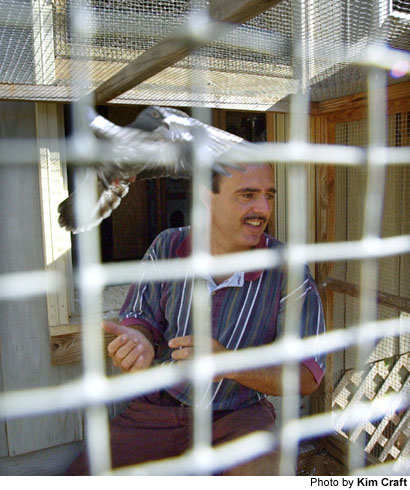
July 18, 2000 — To be honest, when Tim Gago first telephoned me I thought it was a prank call.
He spoke in a thick, high-pitched New England accent. Not exactly something you expect to hear in Northeast Georgia. And what he spoke of seemed even more dubious.
Gago called to tell me about his hobby. No, obsession — Gago called to tell me about racing pigeons.
This was no prank. For Gago and the rest of the Greater Atlanta Racing Pigeon Club, this is serious stuff.
I found out just how serious when Gago, a 42-year-old toolmaker originally from New Bedford, Mass., stopped by The Times office to see me.
He gave me an issue of Racing Pigeon Digest which, according to the magazine’s cover, is “The Thinking Person’s Journal of Racing Homers.” He also handed me some sheets of paper from a spiral notebook. He had written down some thoughts on his aerial avocation.
Four pages. Front and back. Gago ended each sentence with an exclamation point!
His enthusiasm was curious. So was I. Racing pigeons — this I had to see.
I arrived at Gago’s rural Gainesville, Ga. home at 7:30 a.m. on Saturday. He had already been up and active, tending to the 140 pigeons in his two backyard lofts, for more than an hour.
He scraped the pigeon droppings from the loft floors (he does this every day) and refreshed the birds’ water supply. He then captured and caged the 60 birds we were going to take out for practice that morning.
Gago treats his pigeons with special care because, to him, they are special creatures.
“The pigeons underneath the bridge are nowhere related to these birds,” Gago said as we entered one of his lofts. “These are the thoroughbreds of the sky.”
Man has been aware of the homing pigeon’s unique navigational abilities for thousands of years. For centuries, the birds have been used as message carriers. But it wasn’t until the 1800s that pigeons began to be raced for sport.
Racing pigeons are strictly pedigreed, the product of many years of careful breeding. They can be released several hundred miles from their The Atlanta club’s spring racing season culminated with a 600-mile race in June. Birds were shipped to Baltimore and released. Many made it back to their Georgia lofts in roughly half a day, sometimes averaging more than 45 mph.
One of Gago’s birds won. Four finished in the top 10.
We entered Gago’s racing loft, which is right next to his breeding loft, and the birds didn’t seem to notice. Gago breeds his own racing pigeons and can identify each bird, all 140 of them, by sight. Some of the pigeons — “the special ones, only the superstars,” Gago said — have names. Hercules, Chubby, Navigator and Gertrude, for example.
Every bird wears a leg tag that shows its birth date and serial number.
“I’ve got a superior family of pigeons,” said Gago, whose birds are regularly top finishers in the Peach State Combine racing series. “I get satisfaction out of creating and breeding my own birds. I’m the coach, yet I’m a mad scientist. I created them.”
Gago is short and small with a thin black mustache. The birds are comfortable in his presence. Gago mimics a pigeon call and they fly to him. They barely flinch when he reaches out to hold one. I tried to touch a nearby bird and it flew away quickly.
“We’ve got to get going,” Gago said. The sun was rising rapidly. So was the temperature. Soon it would be too hot to train the birds.
We hopped into Gago’s truck and drove 15 miles to the day’s liberation point. There we released the birds in groups of 15.
“Go ahead! Go home!,” Gago yelled to the birds as they left the cage. “Stay away from the wires!”
Each group stayed together. Not one pigeon strayed from its pack. Fifteen specks disappeared together into the cloudless sky.
The pigeons we trained were young birds, those less than one year old. Their racing season begins this fall. In less than three weeks, Gago will have them flying 100 miles in practice.
During the short drive back to Gago’s home, he told me that many of his best racers are descendants of a group of 19 prize birds he purchased in 1988 for $20,000.
“$20,000? Wow,” I remarked.
“That’s what my wife said,” Gago responded with a laugh. Yes, Gago is married, and his wife Sally has been “tolerant” of the birds for 22 years.
We pulled into Gago’s driveway. Three of the four groups of pigeons were already home, milling about outside the loft. The fourth group followed shortly. Still together, they headed straight for the loft.
I was impressed. Gago rewarded his team with a post-practice meal.
No one really knows why pigeons navigate the way they do. They use the sun for orientation, but there is more to it than that. Some scientists believe they can feel the earth’s magnetic field. Others think their senses of smell and hearing play a role.
Gago doesn’t concern himself with any of that. He just knows that his birds always come home — quickly.
“We don’t understand the mystery of life,” Gago said. “God created everything, and I believe that. God created these birds to have homing instinct. They got this way because God wanted them to be that way.”
